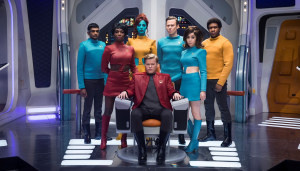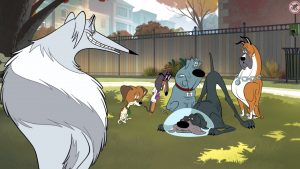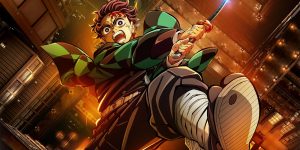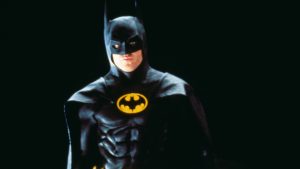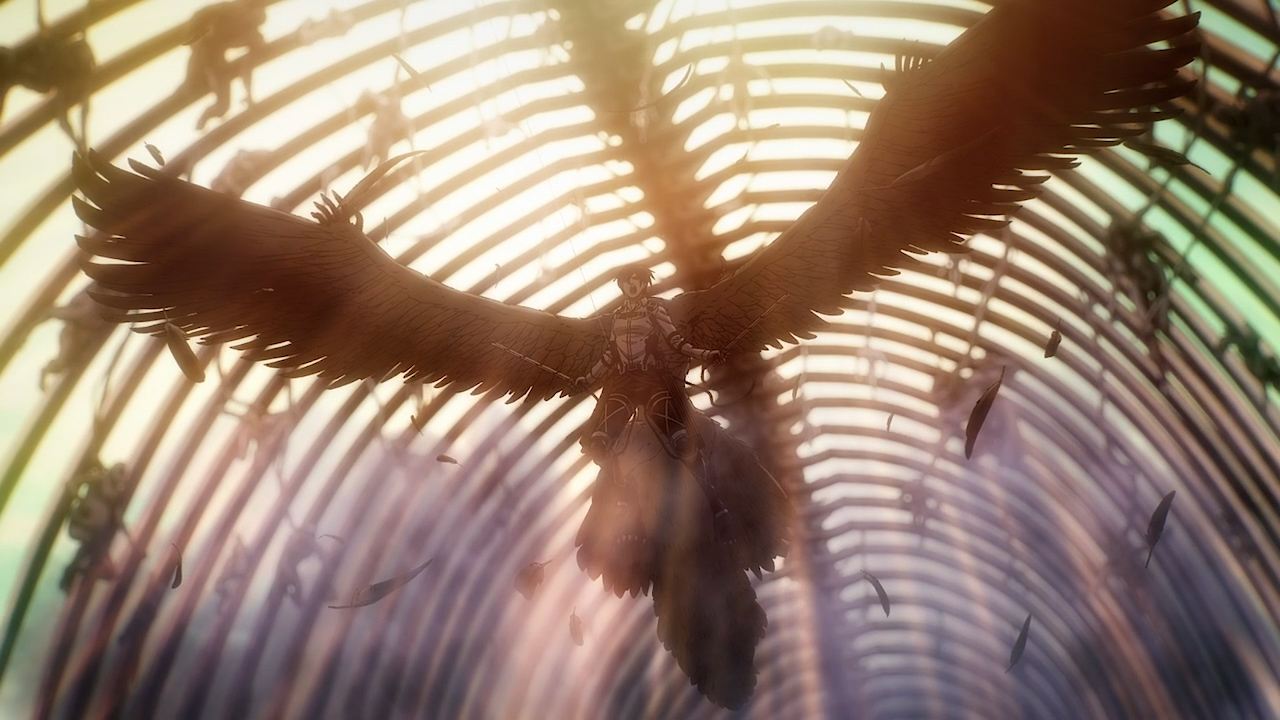
This Attack on Titan: The Final Chapters (Part 2) review contains spoilers.
“In what way are you free?”
The first episode of Attack on Titan aired on April 7, 2013 and forever changed the anime landscape with its contemplative action story about man-eating monsters and the humble heroes who are determined to fight for freedom. Now, a decade later, this war between man and monster has finally reached its end and managed to accomplish something far more impossible than wiping out a world of monsters: it lived up to unbelievable expectations and gave audiences a perfect ending.
There is no shortage of popular, prolific anime, but Hajime Isayama’s Attack on Titan is a rare example of a series that’s confidently held its own with other television pop culture juggernauts like Breaking Bad and Game of Thrones. Like these prestige dramas, Attack on Titan is a masterclass in world-building, character development, and a meditation on humanity’s hubris. Attack on Titan’s legacy was already established long before Attack on Titan: The Final Chapters (Part 2), but after this series finale it’s proven itself as one of the greatest anime of all-time–if not the greatest anime series.
Attack on Titan: The Final Chapters (Part 2) is divided into three chapters that are primarily consumed with the ongoing war against Eren as he leads a Titan Rumbling to trample the world into submission. This basically becomes one long game of Titan Capture the Flag, except the flag is Eren and the cost of failure is the radical culling of humanity. Everyone moves forward towards a common goal that they believe is necessary, all of which encapsulates Attack on Titan’s central theme that these characters have ironically all been “slaves to freedom.”
Attack on Titan’s “freedom fighters” briefly experience a just, empathetic life that’s not reactionary or ruled by fear. This finale provides so many beautiful glimpses of humanity coming together and choosing humanitarian efforts over rage, while regular Eldian and Marleyan civilians come together to help and heal the world. It’s such a touching example of how everyone needs to collaborate during moments like this rather than purely the heroes being essential for success. The entire world works together for a brighter future and this message of cooperation is the perfect theme for the series to go out on and what’s been essential from the start. All it took to learn this lesson was wiping out 80% of humanity.
Attack on Titan’s series finale wants its audience to constantly be thinking about the cost of war and if the end justifies the means. However, it’s also just an utterly gorgeous animated action spectacle. There are stunning fight sequences with mind-blowing choreography and non-stop action where every single character contributes in continuous combat that plays out like Rube Goldberg machinations of epic destruction. There are explosions of fire and steam and viscera and rainbow expressions of power, especially during the final attack against Eren’s Titan. This finale also makes phenomenal use of color and grayscale as a shorthand for power, helplessness, and hope, especially during the infamous baby trampling scene.
The Final Chapters (Part 2) is an 86-minute extravaganza that truly feels like a movie instead of just some extended special. The Final Chapters (Part 1) felt grandiose at 61 minutes, but this finale goes above and beyond with the level of spectacle that’s given to the series’ final hurrah after a decade of consistent storytelling. This is arguably MAPPA’s greatest work and if this finale were in theaters it’d be one of the highest-rated animated movies of all-time. It’s almost a little bittersweet that this isn’t a theatrical experience considering its feature-length runtime.
Every Attack on Titan character receives cathartic closure during The Final Chapters (Part 2), but this finale really celebrates the series’ core trio of Eren, Mikasa, and Armin. They’ve always been Attack on Titan’s heart, even with an increasingly ballooning cast of eclectic affiliations. Armin’s glow-up from the start of the series is absolutely staggering and it’s so satisfying to watch the hero that he’s become. Similarly, Mikasa’s final confrontation with Eren is a series highlight. Perfect editing takes these two through multiple moments in their lives that culminates in this painful, powerful farewell. I burst into tears when “Bird Eren” wraps Mikasa’s scarf around her neck. There are clear parallels between the toxic love between Ymir and King Fritz and Mikasa and Eren. However, Mikasa at least makes it to the other side unscathed. It’s not easy for her to forget about Eren, but she slowly builds a new life for herself.
It’s essential that Armin and Mikasa work out their complicated feelings with Eren during Attack on Titan’s finale, which takes advantage of the audience’s own tangled relationship with this anime’s main character. Eren Jaeger remains one of the most fascinating anime character studies as he’s evolved from protagonist to antihero to villain. This major gambit has played out across multiple seasons and it’s been such a game-changing decision for the medium that highlights what a protagonist truly is, can do, and the legacy that they leave behind – not unlike Attack on Titan as a whole. This finale is all about Eren, his pride, his power, and his deep martyr complex as he throws the world into apocalyptic peril.
There’s a beautiful irony to Eren finally meeting his end in a Titan’s mouth after he triumphantly declares back during the start of the first season, “As if I could die in a place like this.” This full-circle storytelling is complimented through the bleak revelation that Eren is technically responsible for his mother’s death in Attack on Titan’s very first episode as it’s the necessary trigger to keep Bertholdt alive and put the series’ events into motion.
One of the most important moments in The Final Chapters (Part 2) is the deduction that Eren isn’t a genius strategist, Scout Regiment prodigy, or a protagonist who’s fated to be a hero. He’s a dumb, jealous, selfish idiot who lucked into absolute power and crumbled under the pressure. It’s staggering for Attack on Titan to not only acknowledge this reality, but to have Eren himself reach this epiphany while he hangs his head in shame and waits for karma to slap his wrist for genociding 80% of the world. It’s a stark level of honesty that’s extremely rare in an anime of this magnitude. It’s incredibly refreshing and poignant, especially in a world that grows increasingly fragmented and violent by the day.
Attack on Titan’s finale brilliantly undercuts the false premise that a world without Titans will be peaceful and poignantly reminds audiences that man is the worst monster of all. This finale–and the series as a whole–is the ultimate expression of the circle of life and the cyclical nature of war, peace, and everything in between. Attack on Titan elegantly illustrates this through the evocative, powerful visual of The Rumbling’s footsteps that have scarred the world, but continue to birth new life. One of the finale’s bravest decisions is the gut-punch of an end credit epilogue where it’s revealed that despite Eren’s Rumbling gambit, the world is still destined to feud and fall apart. Genocide, rinse, repeat. It’s a resolution that emphasizes Eren’s ignorance and is heavy in real-world nihilism, all of which makes this conclusion hit even harder as Attack on Titan’s final word.
Attack on Titan’s stealth downer ending is guaranteed to make waves, but it’s also exactly what makes all of this work and what sets the anime apart from comparable series like Code Geass. It’s a bitter pill to swallow, but necessary medicine. It will be a long, long time before another anime series reaches the dramatic, thematic heights of Attack on Titan. It’s a warm embrace during a cold front that’s kept its audience safely insulated.
Attack on Titan, thank you for wrapping this scarf around us.
Attack on Titan The Final Chapters (Part Two) is available to stream on Crunchyroll now.
The post The Attack on Titan Ending is Perfect appeared first on Den of Geek.
